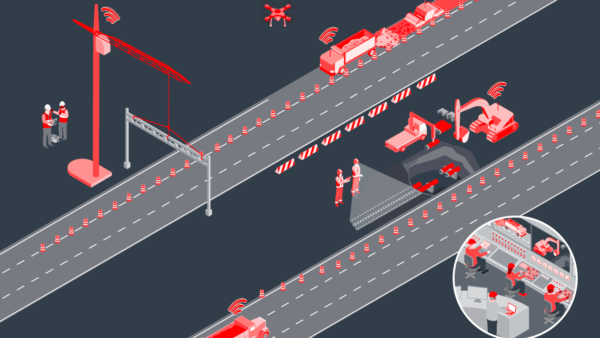Brighten up a ‘gloomy’ start to the year with some of the best information management and digital construction stories you might have missed in 2024. Here are the BIMplus editor’s picks.
WSP outlined its vision of the connected construction site. The engineering consultant highlighted 11 technologies that contribute to a connected construction site.
Eric Peissel, global director for transport and infrastructure at WSP, said: “The core idea behind a connected site is to integrate cutting-edge digital solutions with intelligent infrastructure, creating a cohesive ecosystem where data-driven decisions and real-time collaboration are the norm.”
WSP’s proposal brought together the likes of drone surveying, intelligent compaction, materials tracking, autonomous and remote control plant and cranes, starting with a centralised command and control centre. How close is your site to WSP’s vision?
Malcolm Taylor spent more than a decade as head of technical information at Crossrail from March 2009 to May 2019. In response to BIMplus’s coverage of the government’s report into learnings from Crossrail, he penned a detailed response, detailing his direct experience on the project.
He outlined the asset information management plan for the project that had data for more than 500,000 assets provided by more than 50 construction contracts.
He noted: “When you’re digging tunnels, pouring concrete and battling against time, it’s always a struggle to keep people’s attention focused on the importance of asset information management – this included Crossrail staff as well as contractors. Contractors were used to compiling asset data in their own way at the end of construction and some were resistant to new ways of working: people behaviour problems far outweighed any technical BIM problems we ever had!”
Scott Pilgrim, chief product officer at Operance, called for an end to printed O&M manuals.
He estimated the cost of printing O&M manuals at £103m a year with annual carbon emissions of 456 million kilograms.
“This antiquated practice is not only unsustainable, but also against our company’s core values. We are, after all, a digital business looking to digitise building information,” Pilgrim wrote. “Let’s bid farewell to these relics of the past. Let’s usher in a new era of streamlined, efficient, and eco-friendly building information management!”
Smart buildings: are we smart enough?
A whistle-stop tour of the Smart Buildings Show in the autumn resulted in two stories about digital construction’s new frontier: what do occupiers want from smart buildings and what do developers want from smart buildings and the contractors building them?
The first story revealed that there is a trend for buildings to be overspecified, with poor onboarding of occupiers to technology, leading to technology graveyards as sensors go unused and their information not monitored.
Elizabeth Nelson, co-founder at the Smart Building Collective, said: “There are some buildings in Europe I’m aware of that have a wall of shame. Each time new tenants come in, it’s like starting over – they ask ‘why’ and ‘what do the sensors do’? The sensors stay on the wall and it becomes a bit of a graveyard of technology, some of which is probably still functioning and nothing is being done with it.”
In the second story, SES Engineering Services head of smart building and technology, James Thomas, said: “Contractors need to grasp the nuances of delivering smart and intelligent buildings. I think you will see contractors that will excel at it and others that won’t invest in it because of the uncertainty around the adoption of smart buildings.”
Linden Stephens, head of smart building enablement at British Land, added: “A digital building contractor thinks about selecting trades that get the smart journey, that will have the software to deliver the data we want.”
What does it take to be a digital leader? How best to lead digital teams? Those are the questions Paul Mullett reflected on when he changed jobs in 2024.
Driving digital adoption is akin to a continuous evolutionary journey, he said. “But like any journey, for it to be successful, you need three things: a destination, a driver and a vehicle. For our digital journey, this translates as:
an understanding of market needs and services (the destination);
a people-focused approach (the driver); and,
an appropriate use of digital technology (a vehicle).
“Only a strategy that addresses all three will be successful in driving organisational change.”
That headline…
And finally, in a blatant piece of self-promotion, it would be remiss of me not to mention the best headline on BIMplus in 2024: Welcome home, planetarium. Strictly for the headbangers, but if you know, you know.
Don’t miss out on information management and digital construction news: sign up to receive the BIMplus newsletter.
The post Best of BIM 2024: editor’s picks appeared first on BIM+.


